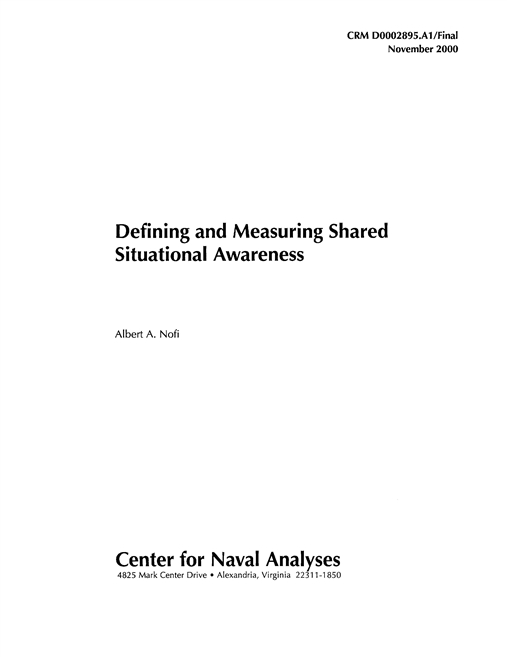The Defense Advanced Research Projects Agency (DARPA) is inter ested in exploring key factors that affect how teams, particularly distributed teams, develop what is called shared situational awareness in an operational environment. The DARPA Program Manager for the Wargaming the Asymmetric Environment program asked the Center for Naval Analyses to address these issues, with subcontracting support from ThoughtLink Incorporated. The focus of the project was to demonstrate how wargaming could be used as a testbed for conducting experiments to explore these key factors in shared situational awareness.
The concept of"shared situational awareness," which underlies some recent ideas about the organization of military staffs, is elusive and ill defined, and does not lend itself easily to traditional scientific evaluation. Nevertheless, it is possible to compose a systematic definition and to develop objective approaches to studying the process by which "shared situational awareness" arises.
Although certainly important, the nature of situational awareness is uncertain. Although there is some confusion in terminology, there is a considerable agreement on what situational awareness is: the result of a dynamic process of perceiving and comprehending events in one's environment, leading to reasonable projections as to possible ways that environment may change, and permitting predictions as to what the outcomes will be in terms of performing one's mission. In effect, it is the development of a dynamic mental model of one's envi ronment. There is also a measure of agreement on what constitutes shared situational awareness and how it develops by a process of inte grating the mission-essential overlapping portions of the situational awareness of individual team members-thus, developing a group dynamic mental model.
However, there is no clearly understandable, generally accepted, objective way to measure situational awareness, whether for individuals or for groups, and little evidence as to the effect of a distributed environment on the development of shared awareness. Nevertheless, despite the enormous uncertainty in the field, it does seem possible to develop situation-specific ways to estimate the degree of situational awareness that a person or group may possess, and from that to be able to make rigorous statistical inferences as to factors that enhance or degrade it.
This possibility has considerable importance, particularly for military and political decision-makers. By better understanding the process by which situational awareness and shared situational awareness develops, we may not only be able to strengthen our ability to develop situational awareness in crisis situations, but may also be able to better understand the enemy's situational awareness, which in turn might permit us to get inside his situational awareness loop to degrade his situational awareness, with potentially important benefits to ourselves.
Download reportAPPROVED FOR PUBLIC RELEASE; DISTRIBUTION UNLIMITED
Details
- Pages: 76
- Document Number: CRM D0002895.A1/Final
- Publication Date: 11/1/2000
